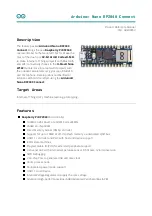
Arduino® Nano RP2040 Connect
Arduino® Nano RP2040 Connect / Rev. 01 - 14/05/2021
10
/
19
3.3 Processor
The processor is based upon the new Raspberry Pi RP2040 silicon (U1). This microcontroller provides
opportunities for low-power Internet of Things (IoT) development and embedded machine learning. Two
symmetric Arm® Cortex®-M0+ clocked at 133MHz provide computation power for embedded machine
learning and parallel processing with low power consumption. Six independant banks of 264 KB SRAM
and 2MB are provided. Direct memory access provides fast interconnect between the processors and
the memory that can be made inactive along with the core to enter a sleep state. Serial wire debug
(SWD) is avaliable from boot via the pads under the board. The RP2040 runs at 3.3V and has an internal
voltage regulator providing 1.1V.
The RP2040 controls the peripherals and digital pins, as well as analog pins (A0-A3). The I2C
connections on pins A4 (SDA) and A5 (SCL) are used for connecting to the onboards peripherals and are
pulled up with a 4.7 kΩ resistor. SWD Clock line (SWCLK) and reset are also pulled up with a 4.7 kΩ
resistor. An external MEMS oscillator (U7) running at 12MHz provides the clock pulse. Programmble IO
helps to the implementation of arbitary communication protocol with minimal burden on the main
processing cores. A USB 1.1 device interface is implemented on the RP2040 for uploading code.
3.4 WiFi/Bluetooth connectivity
Wifi and Bluetooth connectivity is provided by the Nina W102 (U2) module. The RP2040 only has 4
analog pins, and the Nina is used to extend that to the full eight as is standard in the Arduino Nano
form factor with another 4 12-bit analog inputs (A4-A7). Additionally, the common anode RGB LED is
also controlled by the Nina W-102 module such that the LED is off when the digital state is HIGH and on
when the digital state is LOW. The internal PCB antenna in the module eliminates the need for an
external antenna. The Nina W102 module also includes a dual core Xtensa LX6 CPU that can also be
programmed independantly of the RP2040 through the pads under the board using SWD.
3.5 6-axis IMU
It is possible to obtain 3D gyroscope and 3D accelerometer data from the LSM6DSOX 6-axis IMU (U9).
In addition to providing such data, it is also possible to do machine learning on the IMU for gesture
detection.
3.6 External memory
The RP2040 (U1) has access to an additional 16 MB of flash memory via a QSPI interface. The execute-
in-place (XIP) feature of the RP2040 allows external flash memory to be addressed and accessed by the
system as though it were internal memory, without first copying the code to internal memory.
3.7 Cryptography
The ATECC608A Cryptographic IC (U4) provides secure boot capabilities alongside SHA and AES-128
encryption/decryption support for security in Smart Home and Industrial IoT (IIoT) applications.
Additionally, a random number generator is also avaliable for use by the RP2040.




















